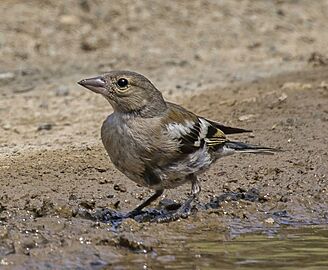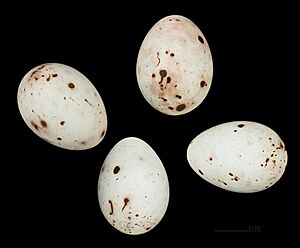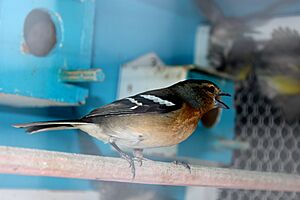Eurasian chaffinch facts for kids
Quick facts for kids Common chaffinch |
|
|---|---|
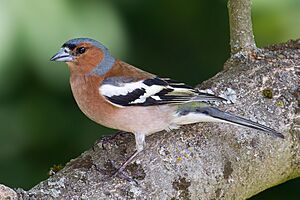 |
|
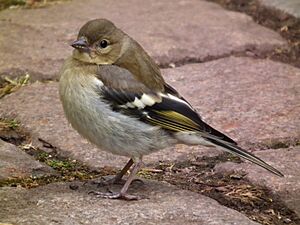 |
|
| Male (top) and female (bottom) in Hessen, Germany |
|
| Conservation status | |
| Scientific classification | |
| Genus: |
Fringilla
|
| Species: |
coelebs
|
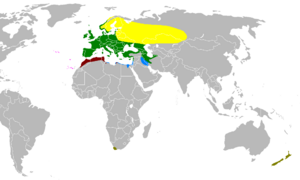 |
|
| Distribution map Summer Resident Winter Introduced canariensis spodiogenys |
|
The Eurasian chaffinch, also known as the common chaffinch or just chaffinch (Fringilla coelebs), is a small, common bird. It belongs to the finch family. Male chaffinches are very colorful with a blue-grey head and rust-red chest. Females are less bright. Both males and females have two white stripes on their wings and white parts on their tail. Male chaffinches sing loudly from high places to find a mate.
Chaffinches live and breed in most of Europe and across Asia to Siberia. The female builds a deep, cup-shaped nest in a tree fork. She usually lays four or five eggs, which hatch in about 13 days. The young birds leave the nest after about 14 days. Both parents feed them for several weeks after they fledge. When it's not breeding season, chaffinches gather in groups in open areas. They look for seeds on the ground. During breeding season, they search trees for insects, especially caterpillars, to feed their chicks. Some chaffinches migrate, meaning they move to warmer places for winter. Birds in colder areas fly south, while those in warm places stay put.
Other animals, like mammals and birds, sometimes eat chaffinch eggs and young. But there are so many chaffinches across a huge area that they are not considered endangered. The International Union for Conservation of Nature says they are of least concern.
Contents
Chaffinch Classification: What's in a Name?
The Eurasian chaffinch was first described by a Swedish scientist named Carl Linnaeus in 1758. He gave it the scientific name Fringilla coelebs. Fringilla is the Latin word for finch. Coelebs means unmarried or single. Linnaeus noticed that in winter, only female chaffinches would fly south from Sweden.
Why is it Called a Chaffinch?
The English name "chaffinch" comes from old words: ceaff (meaning "chaff") and finc (meaning "finch"). Farmers used to thresh their crops, leaving piles of "chaff." Chaffinches would spend weeks looking through these piles for leftover grains. That's probably how they got their name!
Long ago, in 1544, an English scientist named William Turner wrote about the chaffinch. He called it "chaffinche" and also mentioned folk names like "sheld-appel" and "spink." "Sheld" means colorful, and "spink" probably comes from the sound the bird makes.
Finch Family Tree
All birds in the Fringillidae family are seed-eaters. They have strong, cone-shaped beaks. They also have similar skull shapes, nine large primary feathers, and 12 tail feathers. Female finches always build the nest, sit on the eggs, and keep the young warm.
The finch family has two main groups:
- The Carduelinae group has about 28 types of birds and 141 species.
- The Fringillinae group has only one type, Fringilla, with four species:
- The common chaffinch (F. coelebs)
- The Gran Canaria blue chaffinch (F. polatzeki)
- The Tenerife blue chaffinch (F. teydea)
- The brambling (F. montifringilla)
A cool fact: Fringilline finches feed their young mostly insects. Cardueline finches feed their young seeds that they've already eaten and brought back up.
Different Kinds of Chaffinches: Subspecies
There are many different types of Eurasian chaffinches, called subspecies. These types mostly look different in the colors and patterns of the adult male's feathers.
Scientists sometimes disagree on how many subspecies there are. This is because the birds change slightly across their huge living area. For example, the International Ornithological Committee lists 11 subspecies. Other experts might list fewer.
Recent studies using DNA have looked at chaffinches on the Canary Islands. These studies suggest that the chaffinches there are different enough to be considered separate species.
- coelebs group
- F. c. alexandrovi Zarudny, 1916 – northern Iran
- F. c. caucasica Serebrovski, 1925 – Balkans and northern Greece to northern Turkey, central and eastern Caucasus and northwestern Iran
- F. c. coelebs Linnaeus, 1758 (nominate subspecies) – Eurasia, from western Europe and Asia Minor to Siberia
- F. c. balearica von Jordans, 1923 – Iberian Peninsula and the Balearic Islands
- F. c. gengleri O. Kleinschmidt, 1909 – British Isles
- F. c. sarda Rapine, 1925 – Sardinia
- F. c. schiebeli Erwin Stresemann, 1925 – southern Greece, Crete and western Turkey
- F. c. solomkoi Menzbier & Sushkin, 1913 – Crimean Peninsula and southwestern Caucasus
- F. c. syriaca J. M. Harrisson, 1945 – Cyprus, southeastern Turkey to northern Iran and Jordan
- F. c. transcaspia Zarudny, 1916 – northeastern Iran and southwestern Turkmenistan
- F. c. tyrrhenica Schiebel, 1910 – Corsica
What Does a Chaffinch Look Like?
The Eurasian chaffinch is about 14.5 cm (5.7 in) long. Its wingspan is between 24.5 and 28.5 cm (9.6–11.2 in). It weighs about 18–29 g (0.63–1.02 oz).
Male Chaffinch Colors
The adult male chaffinch has a black forehead. Its head, neck, and upper back are blue-grey. Its lower back is a light olive-green. The middle of its back and shoulders are brown. The sides of its head, throat, and chest are a dull rust-red. This color fades to a pale creamy-pink on its belly.
The two middle tail feathers are dark grey. The rest of the tail is black, but the two outer feathers on each side have white parts. Each wing has a bright white patch. There is also a buff-white bar on the inner wing feathers. The main flight feathers are black with white at the bottom.
After the autumn moult (when birds shed old feathers), new feathers grow. These new feathers have buff tips, which make the bird look a bit browner. As winter goes on, the tips wear off. By spring, the brighter colors underneath show through. The chaffinch's eyes are dark brown. Its legs are grey-brown. In winter, its beak is pale grey. In spring, the beak turns bluish-grey with a small black tip.
Female and Young Chaffinches
The adult female chaffinch looks much duller than the male. Her head and most of her upper body are shades of grey-brown. Her belly is paler. Her lower back is a dull olive green. Her wings and tail look similar to the male's. Young chaffinches look like the female.
Chaffinch Songs and Calls
Male chaffinches usually sing two or three different types of songs. Their songs can even sound different depending on the region they live in, like different dialects!
Scientists have studied how young chaffinches learn their songs. A British scientist named William Homan Thorpe found something interesting. If a young chaffinch doesn't hear an adult male's song during a certain time after hatching, it might never learn to sing properly. He also found that if adult male chaffinches are given a certain hormone, they will sing even in November, when they are usually quiet.
Where Chaffinches Live: Distribution and Habitat
Eurasian chaffinches breed in wooded areas. They like places where the average July temperature is between 12 and 30 °C (54 and 86 °F). Their breeding range covers most of Europe. It stretches east across Asia to Siberia.
Chaffinches were brought from Great Britain to other countries in the 1800s. In New Zealand, they spread across both the North and South Islands by 1900. Now, they are one of the most common small birds there. A small group also lives in some suburbs of Cape Town, South Africa.
This bird does not migrate in warmer parts of its home range. But it leaves colder regions in winter. Outside of breeding season, chaffinches form loose groups. Sometimes, they mix with bramblings. They sometimes fly to eastern North America, but some of these might be birds that escaped from captivity.
Chaffinch Behavior: Life Cycle and Habits
Chaffinch Reproduction
Eurasian chaffinches start breeding when they are 1 year old. They usually have one mate for the breeding season. Some, like those in the British Isles, might even stay with the same mate year after year. The time they start breeding depends on how warm spring is. They start earlier in southwest Europe and later in the northeast. In Great Britain, most eggs are laid between late April and mid-June. A male bird sings to attract a female to his territory.
The female builds the nest all by herself. Nests are usually in the fork of a bush or tree, several meters off the ground. The nest is deep and lined with thin roots and feathers. The outside is covered with lichen and spider silk. Inside, there's a layer of moss and grass.
Eggs are laid early in the morning, one each day, until the clutch is complete. A clutch usually has 4–5 eggs. They are smooth and a bit shiny, but their colors vary a lot. They can be pale bluish-green to light red with purple-brown spots or streaks. An average egg is 19 x 15 mm (0.75 x 0.59 in) and weighs 2.2 g (0.078 oz). The female sits on the eggs for 10–16 days to keep them warm.
When the chicks hatch, they are altricial, meaning they are almost naked and have closed eyes. Both parents feed them, but mostly the female. She keeps them warm for about six days. They are mainly fed caterpillars. The young birds leave the nest 11–18 days after hatching. They then spread out. Both parents help feed the young birds for another three weeks. Parents rarely have a second group of chicks in the same year. If they do, they always build a new nest.
Young birds shed some of their feathers around five weeks old. They replace feathers on their head, body, and some wing feathers. Adult birds shed all their feathers once a year after breeding. This takes about ten weeks.
Studies in Britain show that about 53% of young chaffinches survive their first year. About 59% of adult chaffinches survive each year. This means a typical chaffinch lives only about 3 years. However, the oldest chaffinch recorded lived to be 15 years and 6 months old in Switzerland!
What Chaffinches Eat
When it's not breeding season, Eurasian chaffinches mostly eat seeds and other plant parts. They find this food on the ground. They often look for food in open areas in large groups. Chaffinches rarely take food directly from plants. They almost never use their feet to hold food.
During the breeding season, their diet changes to insects. They especially like caterpillars that eat leaves. They look for food in trees. Sometimes, they fly out quickly to catch insects in the air. Young chaffinches are fed only insects. These include caterpillars, aphids (tiny plant-eating insects), earwigs, spiders, and grubs (beetle larvae).
Chaffinch Challenges: Predators and Health
Eggs and young chaffinches are eaten by animals like crows, Eurasian red and eastern grey squirrels, domestic cats. They are probably also eaten by stoats and weasels. Nests started later in spring are less likely to be attacked. This is because there is more plant growth, making nests harder to find. Unlike a similar bird called the brambling, the common chaffinch is not affected by the common cuckoo.
A tiny parasite called Trichomonas gallinae used to only infect pigeons and birds of prey. But starting in Great Britain in 2005, dead European greenfinches and common chaffinches were found with this parasite. The disease spread to Norway, Sweden, Finland, and Germany. Scientists think chaffinches helped spread the disease because many of them breed in northern Europe and spend winter in Great Britain. The number of infected birds found in Great Britain went down after 2006. The number of greenfinches dropped, but the number of chaffinches did not change much.
Chaffinches can also get growths on their feet and legs. These are caused by a virus called Fringilla coelebs papillomavirus. These growths can be small bumps or large growths covering the foot and leg. This disease is not very common. In a 1973 study, only 330 out of about 25,000 chaffinches had these growths.
Chaffinch Status: Are They Safe?
The Eurasian chaffinch lives in a very large area, about 7 million square kilometers (3.7 million square miles). It also has a huge population. There are an estimated 130–240 million breeding pairs in Europe alone. If you count the birds breeding in Asia, the total population is between 530 million and 1.4 billion individuals. There is no sign that their numbers are seriously dropping. Because of this, the International Union for Conservation of Nature says the species is of Least Concern. This means they are not at risk of becoming endangered.
Chaffinches and People
The Eurasian chaffinch used to be a very popular caged songbird. Many wild birds were caught and sold. By the late 1800s, catching them even made their numbers drop in London parks. In 1882, a book suggested that if a parent had a grumpy boy, they should buy him a chaffinch!
People even held competitions where they bet on which caged chaffinch would sing its song the most times. Sadly, sometimes birds were blinded with a hot needle. People wrongly believed this would make them sing more. This cruel practice is mentioned in a poem called The Blinded Bird by English writer Thomas Hardy. In Great Britain, keeping wild chaffinches as pets became less common after laws were passed between 1880 and 1896 that made trapping wild birds illegal.
Today, the Eurasian chaffinch is still a popular pet bird in some European countries. In Belgium, there's a traditional sport called vinkenzetting. In this sport, male Eurasian chaffinches compete to see which one can make the most bird calls in an hour.




